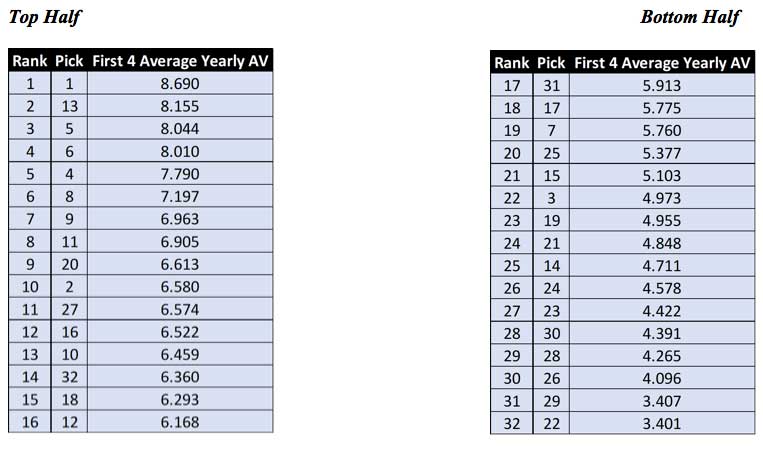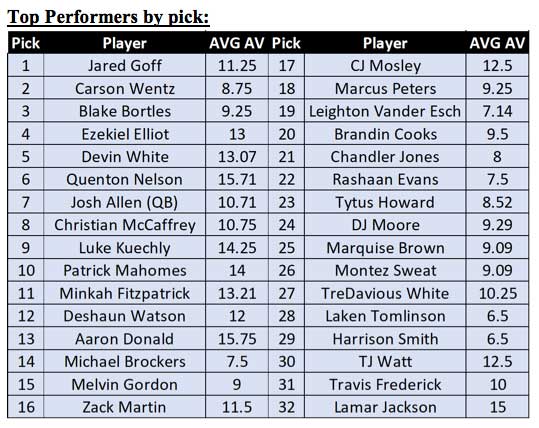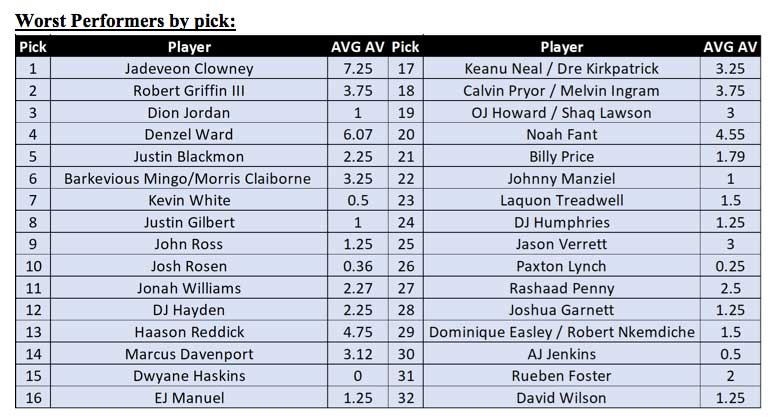Breakdowns
4/14/21
3 min read
Using Approximate Value to Evaluate First-Round Draft Success
Approximate value (AV) is a method created by pro-football-reference in an attempt to put a single number on the seasonal value of a player at any position from any year (since 1950). With this in mind, using it to value “success” creates a standard metric that will allow for the comparison of players. Of course, not all things are equal when it comes to AV -- naturally, QBs have a higher AV than other position groups, but the metric creates a good measuring stick overall.
The question this study attempts to answer is: based on the beginning of a first-round draft pick’s career, which position yielded the most return in terms of average yearly AV? To measure the value of the beginning years of a player’s career, those who have four years, each pick’s average AV over their first four NFL seasons was used. For players that have been in the league less than four years, their performance so far was extrapolated out to estimate their four-year performance. This created a yearly average AV based on the beginning of a player's career.

As can be seen from the table above, the DE, QB, OT and WR positions have yielded the most return in terms of yearly AV out of first-round picks from 2012 to 2019. The OG, S, TE and C positions have yielded the least return yearly in the same data range.
This is consistent with drafting models, as DE/EDGE, QB and OT are positions of extreme value in the first round. The rate of WRs chosen early has increased as well, as 13 WRs went in the first two rounds of the 2020 draft with 2021 having a similar possibility.
To take it one step further, the average return in AV by draft position was observed as well. The natural assumption is that draft picks would have decreasing value as the round progresses, as the best players are usually picked first. Using the average yearly AV of a player’s first four seasons, here is the average return of each draft pick.

As expected, the No. 1 overall pick has returned the most value to his franchise between 2012-2019. It gets interesting after that, with the 13th overall pick coming in second and the 22nd overall pick coming in last.
The 13th pick has seen great success over this 8-year stretch, with many players performing better than expected. Players drafted at 13 include stars like Aaron Donald, Laremy Tunsil and Sheldon Richardson, along with some underachievers such as Michael Floyd and Christian Wilkins.
The 22nd pick has seen plenty of players produce far below expectations; five out of the eight players selected between 2012-2019 produced an average of less than 3.4 AV per season in their first four years. These underperforming players include Josh Doctson, Johnny Manziel and Brandon Weeden. The only players selected at 22 who overproduced were Bud Dupree, Rashaan Evans and Desmond Trufant.
Finally, each pick was analyzed to find which player selected at each draft slot most overperformed their expected AV and which underperformed. The tables below show the top player at each pick and the bottom player at each pick by AV in their first four seasons.










